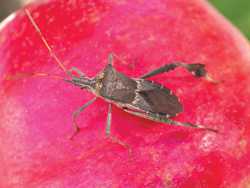Look Out For Leaffooted Bugs

Because leaffooted bugs aren’t a problem in almond orchards every year, it’s easy for growers to get caught off-guard. A good example was the spring of 2006, when the over-wintering pests emerged to take a serious bite out of many growers’ crops.
“Growers didn’t know what was causing it,” says University of California Cooperative Extension entomology farm adviser David Haviland. “It was a big mess.”
About the only good that came out of that year was that entomologists learned a lot about the pest. About an inch long, with a narrow brown body and a yellow zigzag line across its back, the leaffooted bug emerges in spring to begin feeding.
Some years, such as in 2006, there are lots of them, and they can cause a serious problem. Haviland doesn’t expect a repeat of 2006 this year because of one critical difference: In the fall of 2005, populations were quite high. The numbers last fall were not that great, so even if we have an unseasonably warm spring — another key factor — there shouldn’t be major losses. But that doesn’t mean growers shouldn’t be on the lookout this time of year when the bugs emerge because scouting is the only economical way to prevent damage.
Sucking Insects
Scouting is necessary because of the nature of the leaffooted bugs’ damage. They suck the juices out of the nut, so by the time you see serious crop damage, it’s largely too late to do anything.
“If you see nuts dropping on the ground,” says Haviland, “the bug’s been gone for seven to 10 days or so.”Leaffooted bugs hide in the tops of trees and are often camouflaged by the tree canopy, so
Haviland recommends taking a long pole and giving the tree a good whack. If disturbed, the leaffooted bug will take off and usually land nearby, giving you a chance to take a closer look at it and make an ID.
Besides scouting for the pest itself, growers and their PCAs should be on the lookout for the tell-tale gummosis that is associated with the bugs’ feeding. If found, cut cross-sections to confirm that the gummosis is due to leaffooted bug and not some physiological problem such as double-kernel.If you catch them in time, you can knock them out by spraying. Lorsban (chlorpyrifos, Dow AgroSciences) is the most commonly used spray, but some of the new generation pyrethroids can be used. The older pyrethroids were frowned upon, says Haviland, because they could cause bad mite flare-ups.
Variety Makes A Big Difference
If you grow the Fritz variety of almonds, you need to watch those trees even more closely for leaffooted bugs. Because they have very thin hulls — markedly thinner than any other variety — Fritzes are extremely susceptible to damage from the bugs.
“Let’s put it this way,” says Haviland. “If you’re a bug, which one would you want to feed on?”
That’s not to say that other varieties aren’t at risk, says Haviland. Aldrich, Livingston, Monterey, and Carmel also have relatively thin shells, and should also be closely monitored. In comparison, such varieties as Nonpareil, Butte, Mission, Padre, Price, and Winters are not very susceptible to damage. In fact, those varieties even remained relatively unscathed in 2006, a notoriously bad year in which many growers sustained widespread losses.
“If you have a Fritz row next to a Nonpareil row, the Fritz row might get hammered, with half the nuts on the ground,” he says. “But in the Nonpareil row you might just have a few nuts on the ground.”
That said, no almonds have impenetrable shells, Haviland emphasizes. Fritzes simply provide the path of least resistance. There are other factors, such as the hardness of the shell, and because not a lot of research has been done, there could very well be as yet unknown causes.The key for growers is to keep in mind that if there are no Fritz trees about, nor any of the other varieties more prone to damage, the leaffooted bugs won’t simply give up.
“They’re going to eat something, and while they will feed on the easiest available nut, it’s tough to make blanket statements,” he says. “You can’t say ‘I have Nonpareils, I can’t have a problem.’ Yes, you can have a problem.”









